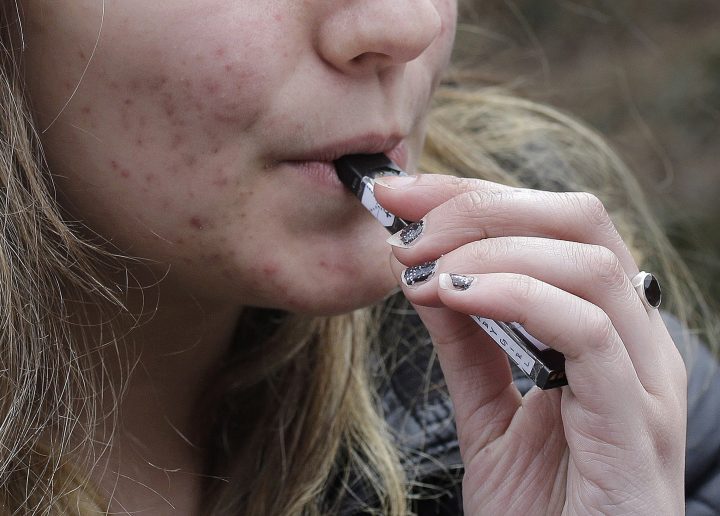Youth vaping rates in Saskatchewan are among the highest in Canada.

Against this backdrop, the province is introducing new measures in an attempt to curb those rates.
One measure coming into force on Sept. 1 is a ban on the sale of vape flavours, with the exception of tobacco, mint and menthol flavours, anywhere but in licensed specialty vape stores.
While there is consensus within organizations that youth vaping needs to be curbed, some are questioning if the government has gone too far — or not far enough — with the measures.
The Lung Association of Saskatchewan was looking for a full ban on the selling of all vape flavours, with the exception of tobacco, in convenience stores.
“We know that that flavoured products absolutely target kids,” said Jennifer May, vice-president of health promotion and government relations with the Lung Association of Saskatchewan.
May pointed to a study from Heart and Stroke on youth vaping. That study states that “nine in 10 ( 92%) young people cite flavours as an important reason why they started vaping and the same number (90%) say it is an important factor for continuing to do so.”
Anne Kothawala agrees that something needs to be done about youth vaping.
However, she calls the ban on flavours in convenience stores a “red herring” that will do nothing to reduce youth vaping rates.
“If you look at when the minister made the announcement, he specifically talked about flavours like ice cream. Flavours like ice cream or cotton candy or unicorn flavours are not flavours that you could ever purchase at a convenience store,” said Kothawala, the president and CEO of the Convenience Industry Council of Canada.
“To be clear, we want a restricted number. We’re not asking to be able to sell hundreds of flavours of vape. We just know that there are a few select, maybe five, six, maximum eight flavours that we know our adult smoking customers, who choose to make that transition, want to be able to buy.”

The Canadian Vaping Association, on the other hand, applauds the decision to restrict flavoured vape to specialty vape stores.
The association’s executive director, Darryl Tempest, said this is not an attack on convenience stores.
“What Saskatchewan has done here is they said, ‘OK, we’re trying to balance regulation, we’re trying to ensure that adults have access while restricting the access points,’” said Tempest.
“Trying to ensure that you don’t get access to this product is really important.”

Get breaking National news
That included taking measures to restrict access to youth before any regulations were brought in, Tempest said.
“It was the vape shops that in advance of any regulation said ‘age-of-majority only,’” he said.
“Restricting access will be key over the short term.”
Kothawala said while the CVA makes a valid argument, she said vape stores don’t have the same track record as convenience stores in selling restricted products, citing tobacco and lottery tickets as examples.
She said there is no evidence pointing to convenience stores as the problem for youth accessing vape products.
“Nobody has presented that evidence, not one single government, nobody has said we have a problem with you,” Kothawala said. “We know what we’re doing and our business depends on it. We are responsible businesses operating in our communities.”
Online marketplace
A growing concern for both the Lung Association and the CICC is the online market.
The concern for May is that there are no checks and balances in that marketplace, especially when it comes to age verification.
Global News knows of at least one case where vaping products were delivered to a home in Saskatoon, and no age verification was done.
What May would like is for Saskatchewan to follow Quebec’s lead and ban the online sale of vape products.
“We have a school that said that they were finding prepaid Visa cards by the handfuls in their garbage in the computer room,” she said. “What they determined was kids were using those prepaid Visa cards to purchase online vape products and then getting them delivered while their parents were at work.”

Kothawala said the lack of third-party verification is the biggest problem, as that is where youth are able to purchase those products, but shutting down the market might be going too far.
“When you think of people that are living in rural Saskatchewan, they don’t have a vape shop around the corner and now they’re not going to be able to purchase perhaps a fruit flavour at their convenience store. So they are, in fact, going to have to rely on the online market,” she said.
“So I think if we went too far on the online market, we’d be punishing some of those adult smokers that have made the switch.”
Whether or not the product is readily available, Tempest said youth will still get their hands on it.
He likened it to youth getting someone who is the age of majority to purchase tobacco or alcohol for them.
“The kids are experimenting with it. Kids experiment with smokes. They experiment with drinking. They experiment, that’s what you do as a kid,” he said.
“So we have this pathway where we’re talking about youth experimentation, so we need to kill the category.”
Adult conversations
Tempest said the one thing missing in any discussion is adult smokers who choose to vape as a means of harm reduction.
He said vaping is twice as effective as any other nicotine replacement product on the market in helping people quit smoking.
“It’s completely asinine, to be honest, because the thought process here is we’re going to take something that’s so successful to get people off of smoking and we’re going to remove it under this whole concept that youth are experimenting with it,” he said.
“Let’s have a real conversation and allow adults to do something that’s going to reduce their harm greatly, specifically around a government push to harm reduction, where we’re decriminalizing so many elements in our society, but we’re criminalizing something that is 90 to 95 per cent less harmful in its entirety (than smoking.)”

May takes issue with Tempest’s statement, saying the CVA is not allowed to make claims their products support cessation.
She said studies show that 84 per cent of vapers are under the age of 25 and that youth who vape are four times more likely to start smoking.
“It is not a harm reduction adult issue like they’re trying to sell us. If the vape industry is so confident that their product will help support cessation, I welcome them to go to Health Canada and apply to become an approved smoking cessation aid. To date, not one company has done that, not one,” she said.
“So what this tells me is that they’ve just been kind of living in a wild west of freedom. Quite frankly, it’s about time governments are now standing up and putting some regulations around this product.”
In a joint submission to Saskatchewan’s health minister on flavoured vape products in 2020, the Lung Association cited statistics stating 30 per cent of Saskatchewan youth reported vaping over a 30-day period in 2019.
Of those youth, 18 per cent of students in grades 7-9 said they during that time frame, with the number rising to 40 per cent of youth in grades 10-12, according to the Lung Association.
Advocacy against youth vaping
The Lung Association started a new campaign two years ago — youth for change.
May said it has been active in educating the government about vape products and advocating for changes in accessibility to them.
“They are going to continue to fight the vape flavours campaign that we want to see in Saskatchewan, a full ban on flavours,” she said.
“It’s a youth and young adult issue. Let’s start treating it as such and really start looking at the information that we have in front of us, not what industry is telling us.”







Comments